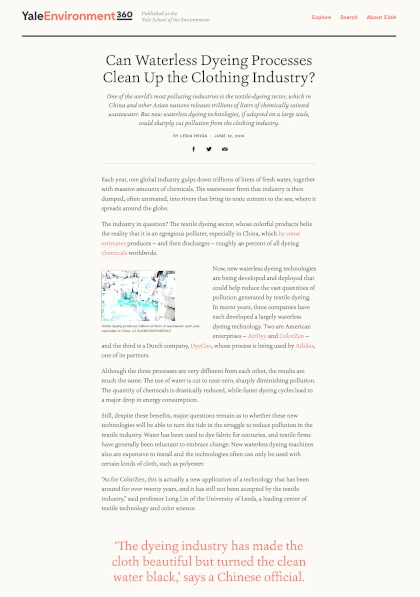Can waterless dyeing processes clean up the clothing industry?
One of the world’s most polluting industries is the textile-dyeing sector, which in China and other Asian nations releases trillions of liters of chemically tainted wastewater. But new waterless dyeing technologies, if adopted on a large scale, could sharply cut pollution from the clothing industry.
Each year, one global industry gulps down trillions of liters of fresh water, together with massive amounts of chemicals. The wastewater from that industry is then dumped, often untreated, into rivers that bring its toxic content to the sea, where it spreads around the globe.
The industry in question? The textile dyeing sector, whose colorful products belie the reality that it is an egregious polluter, especially in China, which by some estimates produces — and then discharges — roughly 40 percent of all dyeing chemicals worldwide.

Expensive machines
Now, new waterless dyeing technologies are being developed and deployed that could help reduce the vast quantities of pollution generated by textile dyeing. In recent years, three companies have each developed a largely waterless dyeing technology. Two are American enterprises — AirDye and ColorZen — and the third is a Dutch company, DyeCoo, whose process is being used by Adidas, one of its partners.
Although the three processes are very different from each other, the results are much the same. The use of water is cut to near-zero, sharply diminishing pollution. The quantity of chemicals is drastically reduced, while faster dyeing cycles lead to a major drop in energy consumption.
Still, despite these benefits, major questions remain as to whether these new technologies will be able to turn the tide in the struggle to reduce pollution in the textile industry. Water has been used to dye fabric for centuries, and textile firms have generally been reluctant to embrace change. New waterless dyeing machines also are expensive to install and the technologies often can only be used with certain kinds of cloth, such as polyester.
Hazardous chemicals
“As for ColorZen, this is actually a new application of a technology that has been around for over twenty years, and it has still not been accepted by the textile industry,” said professor Long Lin of the University of Leeds, a leading center of textile technology and color science.
The need to reform the textile-dyeing industry is urgent, especially in China, Bangladesh, India, Vietnam, and Thailand.
China’s textile industry discharges about 2.5 trillion liters of wastewater into its rivers annually, according to a 2012 report from the non-profit Institute of Public & Environmental Affairs (IPE).
Among these wastes are many hazardous chemicals — tributyltin (TBT), pentabromodiphenyl ether (PBDE), phthalates, perfluorooctane sulphonate (PFOS), and aniline — that are banned or strictly regulated in other countries because they are toxic, persistent, bio-accumulative, hormone disruptive, and can cause cancer.
“The dyeing industry has made the cloth beautiful but [turned] the clean water black,” Sunyun Yao, a country deputy secretary in Shaoxing County, China, said in 2010 at the start of operation Green Storm, which fined or closed down companies illegally discharging untreated wastewater. More than 30 percent of China’s dyeing houses are located in Shaoxing.
Waterless dyeing
According to 2012 statistics from China’s Ministry of Supervision, water pollution accidents in all industrial sectors have risen to more than 1,700 annually — about five a day. But this is not the main concern, says Ma Jun, one of China’s leading environmentalists and founder of the IPE, which created the China Water Pollution Map.
“These toxic spills are emergency situations, but the daily discharge of hazardous substances is by itself already an ongoing disaster,” Ma said. “Some suppliers of brands such as Ralph Lauren, Abercrombie & Fitch, Hugo Boss, and Victoria Secret are very bad polluters, but these brands do not want to face this issue of pollution in their supply chain. This is, in my view, totally irresponsible.”
The intensifying development of waterless dyeing processes has the potential to change things if the technologies are adopted on a large scale, textile experts say. (...)
Publication: Yale Environment 360
Date: June 2014
Would you like to read the entire article?
VIEW FULL STORYBoom time for carbon fibre recycling
Read More

Return to steam power

How Ecover plans to create the Ocean Bottle
Interested in working together?
I'd love to hear from you.